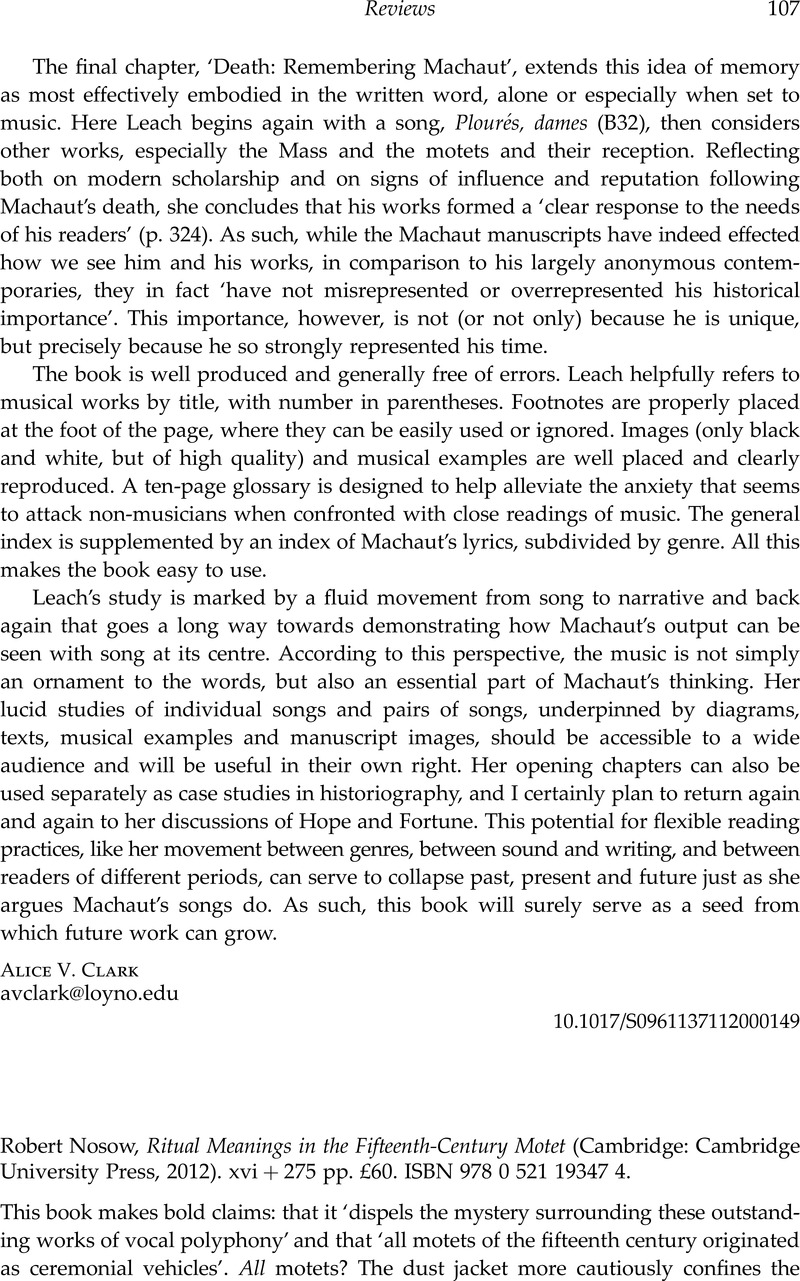No CrossRef data available.
Article contents
Robert Nosow, Ritual Meanings in the Fifteenth-Century Motet (Cambridge: Cambridge University Press, 2012). xvi+275 pp. £60. ISBN 978 0 521 19347 4.
Published online by Cambridge University Press: 12 April 2013
Abstract

- Type
- Reviews
- Information
- Copyright
- Copyright © Cambridge University Press 2013
References
1 Cumming, Julie E., The Motet in the Age of Du Fay (Cambridge, 1999)CrossRefGoogle Scholar.
2 In Music in Medieval Britain (Oxford, 1958) and his edition of Motets of French Provenance, Polyphonic Music of the Fourteenth Century 5 (Monaco, 1968), Frank Harrison set out to classify motets as far as possible ritually on the basis of texts or cantus firmi. I addressed some of the resulting anomalies in ‘The Late-Medieval Motet’, in Companion to Medieval and Renaissance Music, ed. Knighton, Tess and Fallows, David (London, 1992), pp. 114–19Google Scholar.
3 A thorough work scantly acknowledged which may be Nosow's route to this material is Bryant, David and Pozzobon, Michele, Musica devozione città: la Scuola di Santa Maria dei Battuti (e un suo manoscritto musicale) nella Treviso del Rinascimento (Treviso, 1995)Google Scholar.
4 For example, he uses the work of Suparmi Saunders on the watermark dating of the Trent codices, but seems not to know about the different and more broadly based datings put forward by Peter Wright. He refers to the ‘main scribe’ of Trent 87, without apparently knowing of Wright's identifications (pp. 113–17, 191). He misses the opportunity to cite Hallmark, Anne, ‘Protector, imo verus pater: Francesco Zabarella's Patronage of Johannes Ciconia’, in Music in Renaissance Cities and Courts: Studies in Honor of Lewis Lockwood, ed. Owens, Jessie Ann and Cummings, Anthony M. (Warren, MI, 1997), pp. 153–68Google Scholar, which provides further support for claims about Ciconia, and he might have found some relevant material in my ‘Early Papal Motets’, in Papal Music and Musicians in Late Medieval and Renaissance Rome, ed. Sherr, Richard (Oxford, 1998), pp. 5–43Google Scholar.
5 Bologna Q15: The Making and Remaking of a Musical Manuscript. Introductory study and facsimile edition by Margaret Bent (Lucca, 2008), pp. 3–4 and elsewhere. Nosow cites my preliminary article of 1987 instead of its more developed form in the later study.
6 pp. 218 n. 42 and 226–7. Rando, Daniela, ‘Ceremonial Episcopal Entrances in Fifteenth Century North-Central Italy’, Religious Ceremonials and Images: Power and Social Meaning, 1400–1750, ed. Paiva, José Pedro (Coimbra, 2002), pp. 27–46 at pp. 41–2Google Scholar.
7 Gallo, F. Alberto and Mantese, G., Ricerche sulle origine della cappella musicale del duomo di Vicenza (Venice, 1964)Google Scholar, and widely cited since.
8 Noted in the Arnaldi chronicle published in Family Memoirs from Verona and Vicenza, ed. Grubb, James S. (Rome, 2002), p. 18Google Scholar.
9 Padua, Archivio Capitolare, Diversorum 14, fol. 1r, 28 July 1409. Nosow has evidently seen only the incomplete report in Dondi Dall'Orologio, Dissertazione nona, doc. VI, pp. 17–18. Marcello was elected by the senate on 8 July, so there would have been twenty days to prepare the motet.
10 He does not explain why the even-numbered strophes seem to be freely composed. Discussion of this piece gives me an opportunity to correct my commentary to it in Bent, Bologna Q15, no. 175: the Alleluia refrain should follow not every fourth half-stanza, but the third and sixth stanzas.
11 ‘[T]he verse chronicle reflects a later state of affairs … Consequently, Preco preheminencie dates to between September 1416 and December 1418.’ He admits that the Liber metricus supplements material in the Gesta, but does not explain why he treats a literal dating as excluding earlier reference (p. 37).
12 P. 10. Again, he applies a higher bar for hypotheses by others than for his own. A lack of direct reference to the king is maintained except in Cooke's Alma, but Nosow goes on (p. 47) to report just such a direct reference in Damett's Salvatoris mater pia, one of the trio of motets I with due caution associated with the chronicle accounts of the post-Agincourt celebrations, making points that are merely amplified here (‘Sources of the Old Hall Music’, Proceedings of the Royal Musical Association 94 (1967–68), pp. 19–35, at pp. 21–6). Another instance of hypothesis hardening into fact is that Emiliani ‘brought Johannes de Francia with him’ (p. 70).
13 The context for Preco preheminencie might have been enhanced by reference to another English motet for John the Baptist, O amicus / Precursoris. I did not see how Forest's Ascendit Christus leapt from being a memorial for the Assumption (p. 21) to being a commemoration of Bedford's victory in the Battle of the Seine (p. 49).
14 In discussing proportional structures in English works, he neglects to note the pioneering article by Trowell, Brian, ‘Proportion in the Music of Dunstable’, Proceedings of the Royal Musical Association 105 (1978–79), pp. 100–41CrossRefGoogle Scholar.
15 Minor typographical errors include: 35 ‘seige’; 57 ‘Alançon’; 196 ‘lecturn’; 167 ‘Plainchant and Medieval Music’ for Plainsong; 202 ‘kneelet’; and 268 Dunsta/p/ble. On p. 19, why ‘sacerdotes’, not ‘priests’?




